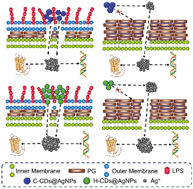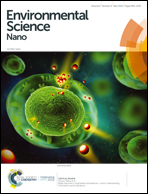Mechanistic studies on the antibacterial behavior of Ag nanoparticles decorated with carbon dots having different oxidation degrees†
Abstract
In this work, carboxylated carbon dots (C-CDs) with higher oxidation degrees or hydroxylated CDs (H-CDs) with lower oxidation degrees were applied to fabricate CDs capped silver nanoparticles (denoted as C-CDs@AgNPs and H-CDs@AgNPs, respectively) via a one-step strategy. These two types of as-prepared AgNPs have similar size, morphology and surface charge. Interestingly, both AgNPs exhibit a higher toxicity against Gram-negative bacteria Escherichia coli (E. coli) than against Gram-positive bacteria Staphylococcus aureus (S. aureus), and the AgNPs decorated with H-CDs with lower oxidation degrees can eliminate both bacteria more effectively. Subsequently, the possible reason for this fascinating phenomenon has been explored clearly in the perspective of nano/cell interface interactions, which has rarely been considered in detail in previous work. The species specific antibacterial activity can be understood by the typical structural difference of the two bacteria, i.e. the presence of hydrophilic lipopolysaccharides (LPS) which facilitate the adsorption of AgNPs onto the surface of E. coli and the absence of hydrophilic LPS and the existence of thicker peptidoglycan (PG) on S. aureus which prevent the adsorption of AgNPs. Interestingly, the adsorption capacity of H-CDs@AgNPs towards E. coli is also much larger than that of C-CDs@AgNPs, while their different abilities to eliminate S. aureus can be interpreted by the faster leakage rate of Ag+ from the H-CDs@AgNPs. The above adsorption capacity has been quantified through the association constants between AgNPs and LPS or PG determined by UV-vis absorption spectroscopy. The above mechanism can also be illustrated by the microscopic analysis and permeability changes of the two bacteria induced by the AgNPs. Our results may provide valuable insights into optimization of other AgNPs for security and practical disinfection application.

- This article is part of the themed collection: Nano-bio interactions


 Please wait while we load your content...
Please wait while we load your content...